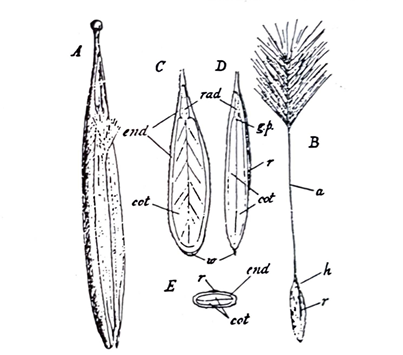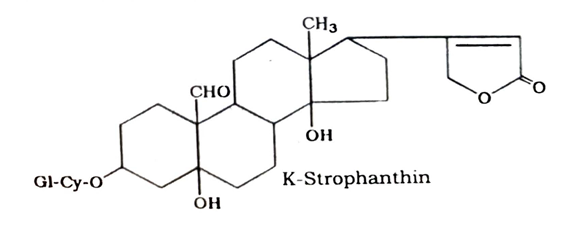Synonyms:
Strophanthi Semina, Strophanthus Seeds.
Botanical Source:
Strophanthus consists of the dried seeds of the seeds of Strophanthus kombe Oliver, freed from the awns. The plants are a climber and belong to the family Apocynaceae.
Geographical Source:
The plant is indigenous to central East Africa, which serves principal commercial source of the drugs.
Macroscopical Characters:
The seeds are about 12 to 17 mm in length, 3 to 5 mm broad, plano-convex and lanceolate in shape with acuminate ends and silvery grey to yellowish green in colour. Endosperm is narrow, oily and white in colour. The embryo extends throughout the whole length of the seed and consists of two leaf-like cotyledons. Odour is characteristic musty and taste very bitter. Reserve food is fixed oil. The raphe extends about two-thirds the length of the seed on the convex side.
Microscopical Characters:
The epidermal cells are polygonal tabular with straight, thick and lignified anticlinal walls. The upper surface of each cell extends into a unicellular trichome. The testa consists of a narrow layer of collapsed thin-walled parenchyma, some of which contain clusters of calcium oxalate. The endosperm and embryo consist of moderately thin-walled parenchyma, which contains abundant fixed oil and aleurone grains.
 Fig. 42: Strophanthus. A, follicle; B, seed; C, D & E, sections of the seed. a; awn; cot, cotyledon; end, endosperm; g,p. growing point of emb~’o; h, hilum; i, raphe; rad, radicle; w, winged extension (Adopted from Wallis).
Fig. 42: Strophanthus. A, follicle; B, seed; C, D & E, sections of the seed. a; awn; cot, cotyledon; end, endosperm; g,p. growing point of emb~’o; h, hilum; i, raphe; rad, radicle; w, winged extension (Adopted from Wallis).

Chemical Constituents:
The seeds contain 8 to 10 percent of a cardioactive glycoside mixture, K-strophanthin, and about 3O percent of fixed oil. Their other constituent included kombic acid, the alkaloids, choline and trigonelline, resin, mucilage, and calcium oxalate.
Uses of Strophanthus:
Strophanthus is a strong cardiotonic. It is used as a life-saving drug when life is threatened from failing heart. It strengthens the heart muscle and is highly effective in the treatment of congestive heart failure.
Substitutes and Adulterants:
The dried seeds of various other species of Strophanthus have been frequently used as substitutes and adulterants of Strophanthus.

